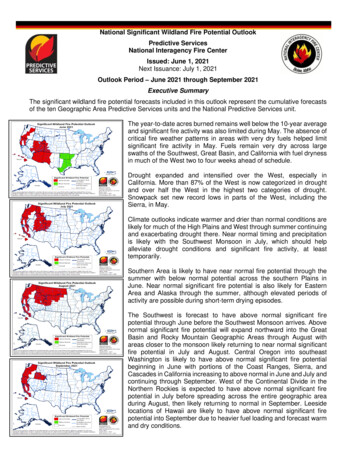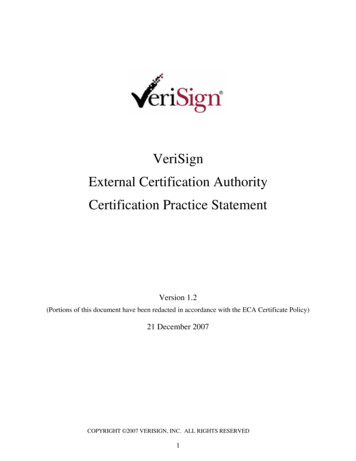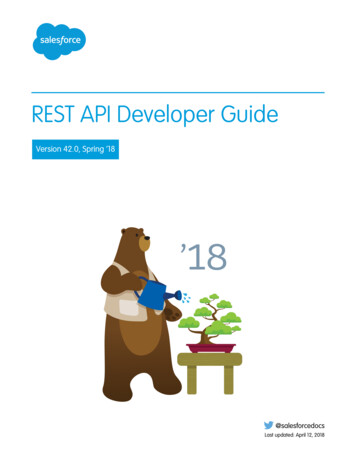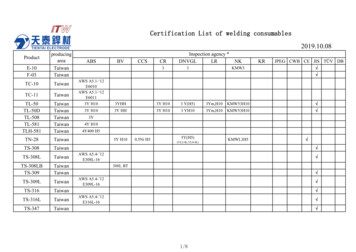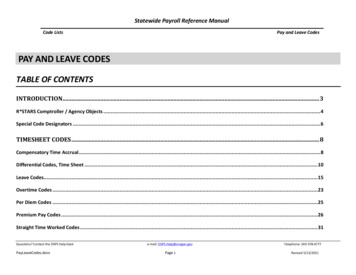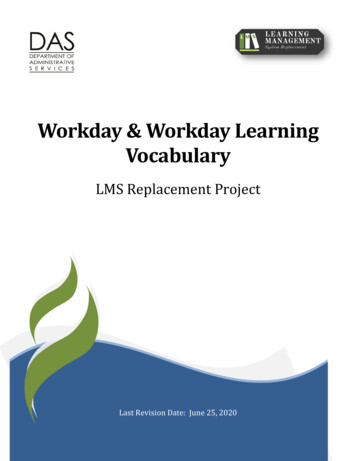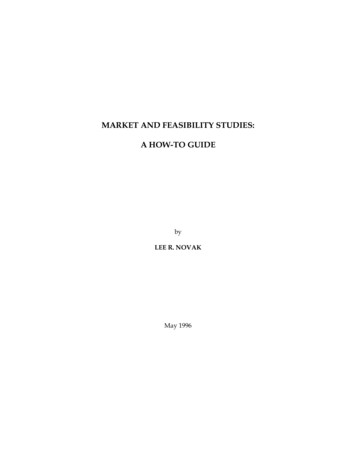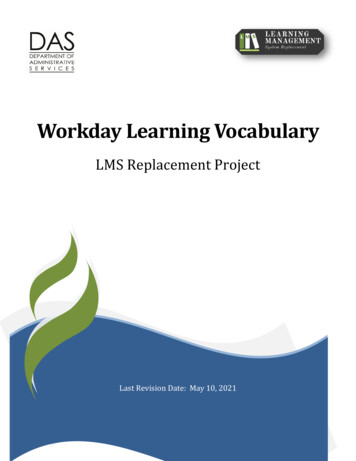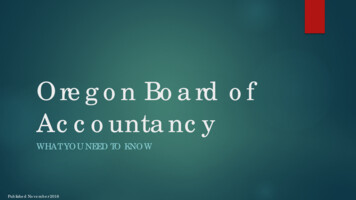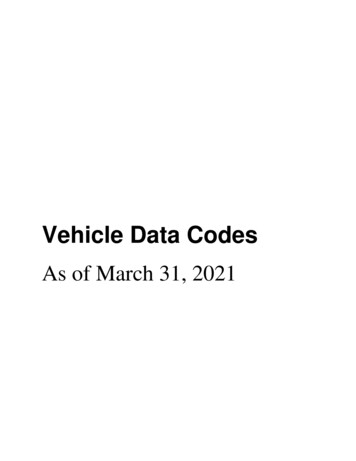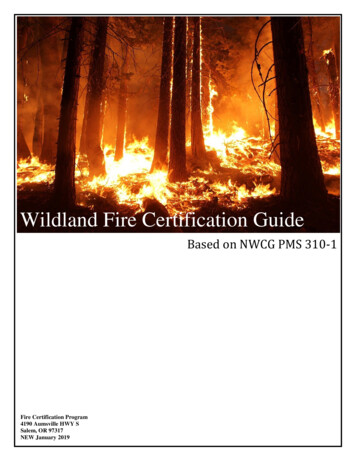
Transcription
Wildland Fire Certification GuideBased on NWCG PMS 310-1Fire Certification Program4190 Aumsville HWY SSalem, OR 97317NEW January 2019
Note to ReaderOn March 14, 2018, the Wildland Task Force convened at the Department of Public Safety Standardsand Training (DPSST) at the direction of the Fire Policy Committee (FPC) to review and discuss therevisions to the Operations section of the National Wildland Coordinating Group’s (NWCG) PMS 310-1National Incident Management System: Wildland Fire Qualification System Guide (PMS 310-1). TheTask Force determined it is in the best interest to the Oregon fire service to continue with the adoptioninto Oregon Administrative Rule (OAR) of PMS 310-1 in addition to formally adopting NWCG’s PMS901-1 Field Manager’s Course Guide (PMS 901-1) which works in conjunction with PMS 310-1.According to NWCG, PMS 310-1 outlines minimum requirements for training, experience, physicalfitness level, and currency standards for wildland fire positions, among other additional qualificationrequirement information. Additionally, PMS 901-1 provides detailed administrative informationregarding the requirements for NWCG training curriculum and instructors. By adopting PMS 901-1, theTask Force acknowledged these proposed changes are significant and would require DPSST to providefurther education to the Oregon fire service. DPSST offered to create a “Suggested Course Guide” toassist in this transition period to help explain these proposed changes.The primary area affected by the adoption of PMS 901-1 is the approval of DPSST certified Wildlandinstructors. Historically, it has been written into OAR that a DPSST-approved instructor must becertified or trained in the subject area they are teaching and either be certified as an NFPA FireInstructor I or be a Content Expert. If approved, the adoption of PMS 901-1 generally would require thelead instructor of a Wildland course be certified at a higher level than the class he or she is applying toinstruct, in addition to having 32 hours of acceptable formal instructional training (i.e. a DPSST certifiedNFPA Fire Instructor I, M-410 Facilitative Instructor course, etc.). For example, in order to instruct S130 Firefighter Training (one of the courses required to be certified as a Firefighter Type 2 [FFT2]), thelead instructor must be a qualified single resource boss, such as Engine Boss, Single Resource (ENGB).Or, in order to instruct S-230 Crew Boss (a required course for single resource certifications), the leadinstructor must be certified in either Strike Team Leader Engine (STEN) or Task Force Leader (TFLD). Formore information on the new instructor requirements, please see DPSST’s Wildland Fire InstructorGuide.Wildland Fire Certification Guide 2019Page 1 of 16
Frequently Asked Questions:Q:NWCG has combined both S-131 and S-133 into one course under S-131. Why does theapplication still require S-133? Do all applicants need to take both courses?A:The answer depends on when the applicant took S-131. One major issue affecting the Oregonfire service was NWCG’s decision to remove the S-133 Look Up, Look Down, Look Around curriculumand incorporate it into the S-131 Firefighter Type 1 course. The Wildland Task Force recognizes thatthough S-133 is a short class, it contains vital information necessary for certification as an FFT1. Also,taking note that NWCG did not remove the curriculum completely and instead incorporated it into S131’s curriculum; they determined it is still required information for an FFT1 to have. The Task Forcedetermined anyone who is not yet a DPSST certified FFT1 that took S-133 before October of 2016(when S-133 was combined with S-131 curriculum) will either need to take S-133 or retake S-131 withthe updated curriculum. Anyone who is not yet a DPSST certified FFT1 that took S-131 after October of2016 will have taken the course with the updated curriculum and will not need to take S-133. For thosethat need the S-133 course, NWCG no longer offers this curriculum but it can still be found throughoutOregon fire agencies, training associations, and DPSST.Q:NWCG updates PMS 310-1 and 901-1 every October. Will Oregon Administrative Rule (OAR)be updated every year to reflect NWCG’s updates?A:No. PMS 310-1 and PMS 901-1 are traditionally reviewed and updated by NWCG every year. TheWildland Task Force discussed the frequency of NWCG updates and recommended removing detailedrequirements of certification and instructor applications from OAR, and instead write the OAR in a waythat will allow for slight changes in PMS 310-1 and PMS 901-1 without have to gather a Wildland TaskForce each year. The Task Force agreed minimal changes will occur and has the understanding thatshould a major change occur or a Wildland Task Force hasn’t convened within five years of theprevious update, another Task Force will be assembled to discuss the requirements and relevance ofthe standards to the Oregon fire service. Please familiarize yourself with both NWCG 310-1 and 901-1each time they update for potential changes that could affect you or your agency.Q:I have a Wildland certification from several years ago that has a different title than the newcertifications. How will this appear on my Maintenance Re-Certification Forms/SnapShot?A:Maintenance Re-Certification Forms/SnapShot records will continue to show certificationsawarded at that time. The local jurisdiction and DPSST will follow the Wildland CertificationEquivalency Chart on the next page to determine the fire service professional’s equivalentcertification(s).Wildland Fire Certification Guide 2019Page 2 of 16
Wildland Certification Equivalency ChartPrevious Certification Levels Current Certification Levels(DPSST Oregon Specific)Under PMS 310-1Wildland Interface Fire Fighter(FFT2)Firefighter Type 2 (FFT2)Advanced Wildland InterfaceFire Fighter (FFT1)Firefighter Type 1 (FFT1)Wildland Interface Engine BossWildland Interface Crew BossN/AN/AN/AWildland Interface Strike TeamLeader EngineWildland Interface Strike TeamLeader CrewN/AWildland Interface StructuralGroup SupervisorWildland InterfaceDivision/Group SupervisorWildland Fire Certification Guide 2019Engine Boss, SingleResource, (ENGB)Crew Boss, Single Resource(CRWB)Heavy Equipment Boss,Single Resource (HEQB)Felling Boss, SingleResource (FELB)Firing Boss, Single Resource(FIRB)Strike Team Leader Engine(STEN)N/ATask Force Leader (TFLD)N/ADivision/Group Supervisor(DIVS)Page 3 of 16
Wildland Fire Certification InformationBelow you will find excerpts from PMS 310-1 which is revised every October. Please use the followinglink for additional information: ons/pms310-1.pdfPOSITION COMPETENCY AND BEHAVIOR GUIDANCEThe U.S. Fire Administration (USFA) and the National Wildfire Coordinating Group (NWCG), working onbehalf of the National Integration Center, Incident Management Systems Integration Division(Department of Homeland Security), identified and compiled a master list of the core competenciesand behaviors for each Incident Command System (ICS) position identified in the National IncidentManagement System (NIMS). Using the master list of NWCG also identified competencies andbehaviors for all remaining positions identified in the NIMS Wildland Fire Qualification System Guide,PMS 310-1.The competencies and behaviors form the basis for position-specific training, PTBs, job aids, and otherperformance-based documents.The three primary benefits of identifying competencies: Competencies are a national “benchmark”; they standardize qualifications without interfering withlocal decision-making about training. Shared competencies make interagency crossover and collaboration easier. Competencies are a critical component for the development of performance-based training.The following brief definitions have been established: Competency – A broad description grouping core behaviors necessary to perform a specific function. Behavior – A general description of an observable activity or action demonstrated by an individual ina particular context. Task – A specific description of a unit of work activity that is a logical and necessary action in theperformance of a behavior; how the behavior is demonstrated or performed in a particular context.Competencies and behaviors across the ICS positions are similar. This similarity may hide criticaldifferences in proficiency level and the environment or type of incident in which the position isexpected to perform. These critical differences are typically captured in the task identified for eachposition. Each all-hazards discipline will determine which competencies and behaviors apply topositions identified within their discipline, and will develop tasks to support the competencies andWildland Fire Certification Guide 2019Page 4 of 16
behaviors for each position. If a discipline wishes to deviate from these master competencies andbehaviors, they will be required to work with the National Integration Center for adjudication andapproval.Approved competencies and behaviors by position are located ooks.DESCRIPTION OF THE PERFROMANCE-BASED SYSTEMIn the performance-based Wildland Fire Qualification System, qualification is based on completion ofrequired training and completion and certification of the applicable NWCG PTBs on wildland fires,events, incidents, job activities, and in simulated exercises or classroom activities. The primary criterionfor qualification is individual performance as observed by an Evaluator.Evaluators must be either qualified in the position being evaluated or supervise the Trainee; FinalEvaluators must be qualified in the position they are evaluating.The successful performance must then be properly documented in an approved PTB. The PTB containsall critical tasks that are required to perform the job. The process of demonstrating the abilities toperform the position is the completion of a PTB. The tasks in each NWCG PTB have been established bysubject matter experts from all NWCG agencies and geographical areas of the United States, andtested and approved by the NWCG.NWCG PTBs must be used for wildland fire, incident support, and associated activities positioncategories. For positions in the ICS category that do not have tasks specific to wildland fire, other allhazards PTBs may be used as per agency direction. Positions in the ICS category that do have tasksspecific to wildland fire must utilize the NWCG task book.Position task books are formatted to allow documentation of a Trainee’s ability to perform each task.Tasks pertaining to tactical decision-making and safety require position performance on a wildland fire.Remaining tasks may be evaluated through other means such as a simulation or performance on anemergency or nonemergency incident/event.The basis for recommending agency certification is successful completion of all required tasks of theposition, as determined by the Evaluator(s) and Final Evaluator. Certification and documentation ofcompleted PTBs is the responsibility of the Certifying Official from the home unit/agency (this includesthe employing agency when applicable).Individuals are responsible for providing proof of qualification on an incident.Wildland Fire Certification Guide 2019Page 5 of 16
POSITION QUALIFICATIONSRequired TrainingRequired training provides a direct link between training and job performance to provide for responderhealth and safe operations on wildland fires. Required training cannot be challenged except for thefollowing conditions:1. Structural firefighters may use the Skills Crosswalk for qualification in FFT2, FFT1, ENGB and/or STEN.Those using the Crosswalk must use the identified gap course material (G-131, G-231, G330) andobtain appropriate course certificates. Refer to the Crosswalk for Structural and Wildland Firefighterssection of the PMS 310-1 for further guidance.2. Agencies may establish processes for approving and documenting course equivalencies to requiredNWCG training by following the “NWCG Course Equivalency Guidelines” in the Field Manager’s CourseGuide, PMS 901 1.Position task books can be initiated before attendance and successful completion of required training.However, Trainees cannot become fully qualified for the position until required training has beensuccessfully completed. A Trainee must be qualified in the prerequisite position(s) before a PTB can beinitiated.Agency-equivalent courses and courses that are interchangeable as identified by the NWCG Operationsand Training Committee may be substituted for required courses. For information on interchangeablecourses and course equivalency guidelines, see the Field Manager's Course Guide, PMS 901-1 t TrainingIn order to maintain currency, some positions have identified recurrent training (RT) at variousintervals.For more information, consult the Field Manager’s Course Guide, PMS 901-1.Required ExperienceRequired experience includes qualification in any prerequisite position and completion of the PTB.Required experience cannot be challenged except for the following conditions:1. Agencies may establish processes for approving and documenting equivalent experience followingthese principles:a. Documentation supporting “Required Experience” must show a direct relationship to thecompetencies, behaviors and tasks relative to the specific NWCG qualification.Wildland Fire Certification Guide 2019Page 6 of 16
b. Documentation supporting “Required Experience” should be verifiable and be current enough toreflect the individual’s capability.c. Documentation supporting “Required Experience” may come from within or from outside of therespective agency.Currency RequirementsFor the positions identified in this guide, the maximum time allowed for maintaining currency is 3 yearsfor air operations, faller, and dispatch positions. All other positions have a 5-year currencyrequirement.Currency for a position can be maintained by successful performance within the given timeframes inthat position or successful performance as a Trainee or Qualified in positions identified in this guide.POSITION TASK BOOK DESIGN AND USEPosition Task Book InitiatedA Trainee must be qualified in any prerequisite position before the next level PTB can be initiated. ATrainee cannot be assigned to an incident unless they are designated as a Trainee on their IncidentQualification Card or other agency proof of certification.Position Task Book Completion TimeframesAs of the publication date, the standards established in this edition of PMS 310-1 will be met by allparticipating agencies. Individuals who have begun the process of qualifying for a position underprevious editions can continue to use those standards as long as they complete the process before theexpiration deadlines as noted below.Any individual who has begun the evaluation process need not take any newly required course(s) forthat position. Additionally, personnel who are qualified in a position before the implementation of thisrevision may retain certification at the discretion of their agency. To qualify in any other position, theindividual must meet the standards identified herein.Position task books have a limited time in which they can be completed:A PTB is valid for 3 years from the day it is initiated. Upon documentation of the first task in thePTB, the 3-year time limit is reset from that new date.If the PTB is not completed in 3 years from the date of the PTB initiation (or first task being evaluated),the PTB will expire. A new PTB may be initiated. Prior experience documented in the expired PTB maybe taken into account in completion of the new PTB at the discretion of the Certifying Official. AllWildland Fire Certification Guide 2019Page 7 of 16
current qualification standards identified in this document must be applied at the time of the new PTBinitiation.POSITION TASK BOOK CONSIDERATIONS AND EXCEPTIONSPositions With Combined Position Task BooksThese PTBs have been combined to include common tasks—with additional tasks for specific positionsas referenced. The common tasks only need to be completed once. When the PTB is initiated, theapplicable position(s) should be identified by crossing out the nonapplicable positions on the cover. Foreach subsequent position, a new “front cover initiation” page and a new “verification/certification”page must be printed and initiated (with the applicable position being identified by crossing out thenonapplicable positions on the cover).Combined Position Task Books With Common Tasks:3. Single Resource Boss (CRWB, HEQB, ENGB, FELB, FIRB, and HMGB)4. Strike Team Leader (STCR, STEN, STEQ) and Task Force Leader (TFLD). For qualification as a StrikeTeam Leader, the specific Strike Team Leader PTB must be initiated (with the applicable position beingidentified by crossing out the nonapplicable positions on the cover).The Strike Team Leader tasks only need to be completed once. Once qualified as a Strike Team Leader,any additional Single Resource Boss qualifications will allow agencies to qualify the individual in thecorresponding Strike Team Leader position. An additional PTB for that position does not need to becompleted. Certification must be documented on a “verification/certification” page.Once qualified as a Strike Team Leader, to become a TFLD, a new “front cover” page and a new“verification/certification” page must be printed and initiated (with the applicable position beingidentified by crossing out the nonapplicable positions on the cover), and the additional tasks in the PTBfor TFLD must be completed.For an individual using the TFLD alternate pathway of two Single Resource Boss ICT4 versus goingthrough STL, a TFLD PTB must be initiated (with the applicable position being identified by crossing outthe nonapplicable positions on the cover) and all tasks in the PTB must be accomplished and evaluated.Note: If a TFLD meets the prerequisite experience and qualifications of a STL, the appropriate STLqualification may be granted by the certifying official. Certification must be documented on a“verification/certification” page.Wildland Fire Certification Guide 2019Page 8 of 16
Wildland Fire Operation PositionsFirefighter Type 2 (FFT2)(Position Category: Wildland Fire)REQUIRED TRAININGBasic Firefighter Training: Introduction to ICS (ICS-100)Human Factors in the Wildland Fire Service (L-180) Firefighter Training (S-130)Introduction to Wildland Fire Behavior (S-190) NIMS: An Introduction (IS700)Annual Fireline Safety Refresher (RT-130)*REQUIRED EXPERIENCENonePHYSICAL FITNESS LEVELArduousTHESE POSITIONS MAINTAIN CURRENCY FOR FFT2Division/Group Supervisor (DIVS)Fire Effects Monitor (FEMO)Firefighter Type 1 (FFT1)Helicopter Crewmember (HECM)Incident Commander Type 3 (ICT3)Incident Commander Type 4 (ICT4)Incident Commander Type 5 (ICT5)Prescribed Fire Burn Boss Type 1 (RXB1)Prescribed Fire Burn Boss Type 2 (RXB2)Any Single Resource Boss (CRWB, FIRB, ENGB, FELB, HMGB, HEQB) Any Strike Team Leader (STCR, STEN,STEQ)Structure Protection Specialist (STPS) Task Force Leader (TFLD)FFT2 MAINTAINS CURRENCY FOR THESE POSITIONSNoneOTHER TRAINING WHICH SUPPORTS DEVELOPMENT OF KNOWLEDGE AND SKILLSNone*Annual Fireline Safety Refresher (RT-130) is not required for the first year as a Firefighter Type 2 (FFT2);however, it is required for subsequent years.Note: For the Firefighter Type 2 (FFT2) position, satisfactory completion of the required training meets theposition qualification requirements.Wildland Fire Certification Guide 2019Page 9 of 16
Firefighter Type 1 (FFT1)(Position Category: Wildland Fire)REQUIRED TRAININGAnnual Fireline Safety Refresher (RT-130) Firefighter Type 1 (S-131)Look Up, Look Down, Look Around (S-133)REQUIRED EXPERIENCESatisfactory performance as a Firefighter Type 2 (FFT2) Successful position performance as a Firefighter Type 1 (FFT1) on a wildfire incidentPHYSICAL FITNESS L
instruct, in addition to having 32 hours of acceptable formal instructional training (i.e. a DPSST certified NFPA Fire Instructor I, M-410 Facilitative Instructor course, etc.). For example, in order to instruct S-130 Firefighter Training (one of the courses requ
